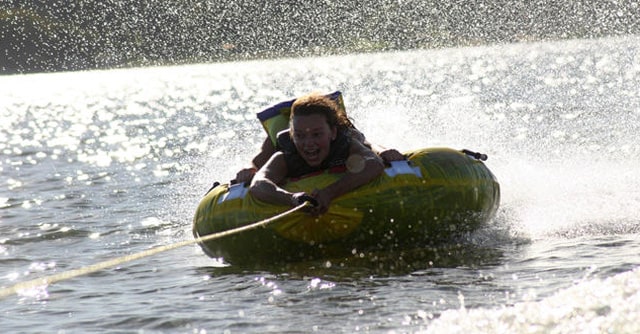4 FAQs about water activities

We've been talking a lot this summer about summer vacations, repelling down waterfalls and preventing moisture damage to your pump. Today, we welcome back Amy Kellerman, a product specialist on our insulin delivery marketing team, to continue on that theme to talk about what to do with your pump and CGM for different water situations.
It's that time of year when we all want to get out of the summer heat and go for a refreshing swim. However, you might be wondering what you can and can't do with your insulin pump and CGM in water situations.
While manufacturers design insulin pumps to be sturdy (Medtronic pumps are actually made from the same material as motorcycle helmets!), any durable pump can develop tiny cracks that make it susceptible to water damage. Often you can't even see these micro-cracks, but they're there thanks to all those little bumps and drops that come with living with your pump every day.
That's why we make our pumps water resistant, meaning they can withstand rain or accidental splashes, but you should avoid submerging your pump in water.
So, what does that mean for your daily life? Check out answers to some of your most frequently asked questions on water activities.
What do I do with my pump when I take a shower?
Hopefully, this is your most common water activity :-). As you probably already know, just disconnect the pump and belt out your favorite shower song without worrying about possible water damage due to micro-cracks (or trying to find a place to put your pump).
What should I do with my pump when I go swimming?
Since your Medtronic pump is splash proof, but not waterproof, you don't want to submerge it in water. If you are going to swim, surf, snorkel or enjoy any other water activity, disconnect from your insulin pump for up to one hour and put it someplace safe. After all, your pump is an important, expensive and sensitive piece of medical equipment. You don't want to lose it at the bottom of a lake or ocean! So, splash freely! And if you're new to the big waves, go see our favorite California girl, Karmel Allison for some first-time surfer/pumper tips. Of course, while you're disconnected, be sure to test often and be prepared with both fast-acting insulin and glucose.
Talk with your healthcare provider to establish a plan if you're going to regularly disconnect for swimming or other activities.
What if I get stuck in the rain with my pump?
If you get stuck in one of those balmy August t-storms, just dry off your pump when you get inside and continue to use it normally.
What should I do with my CGM while in the water?
Once the MiniLink transmitter (the part shaped like a seashell) and sensor are connected, they form a water-tight seal to a depth of 8 feet for up to 30 minutes. So you can shower and swim without removing them. But you'll want to avoid taking really hot baths or soaking in a jacuzzi, since the really hot water can reduce the sensor's life.
The Guardian® REAL-Time monitor is not waterproof so you should store it someplace safe during water activities. Your pump or Guardian® REAL-Time monitor won't display current CGM data if it's out of range (beyond 6 feet). However, the MiniLink does have 40 minutes of memory that will be communicated to the pump once you're back in range (whether or not you're connected to the pump). If you're away for more than 40 minutes, you will see a data gap when you upload to CareLink.
To sum it up, enjoy these last few weeks of summer! Go body surfing, enjoy the water park, jump off the high dive or do some laps - without worrying about micro-cracks or feeding your precious pump to the fishies.




Blog comments
Hi Joy - this is a great conversation to have with our 24 HelpLine. Please give them a call at 800.646.4633, option 1.
I have a daughter on the mini link real time sensor and transmitter , is his Transmitter the part that looks like a shell water proof?
Karen, when the transmitter and sensor are connected, they form a water-tight seal to a depth of 8 feet for up to 30 minutes.
hey, nice article. and thanks for suggestions.. it really useful tips...
I have a water related question regarding the guardian 3 transmitter when scuba diving. Should I remove the transmitter from my body if I go more than 30 feet deep in the ocean during scuba?
Good question. The CGM transmitter, when connected with a Guardian Sensor 3, is watertight to a depth of 8 feet for up to 30 minutes so you should remove it when going that deep for an extended period of time.
Hello. I understand that CGMs can be worn while swimming, but what about geothermal pools (i.e., the Blue Lagoon in Iceland). I read the above messaging that states "avoid taking really hot baths or soaking in a jacuzzi, since the really hot water can reduce the sensor’s life"
Actually, I plan on removing pump/CGM during this activity, but curious about the remaining embedded sensor that I plan on leaving in. Are there 'dummy' transmitters that can be attached to the sensor or 'just don't worry about it'.
Thanks
Thanks for reaching out, Chris. If the water is 104˚F or less, you are fine to leave both your sensor on and connected for up to 30 minutes. Anything over 104˚F can decrease the life of your Enlite/Guardian Sensor 3. We do not carry non-working transmitters, but our 24-Hour HelpLine may be able to provide best practice suggestions for you. You can reach them at your convenience at 800.646.4633, option 1.
hello...i was cleaning the transmitter this morning, and got the transmitter wet. It is no longer working. What to do?
I'm sorry to hear this, Mark. If you haven't already, please reach out to our 24-Hour HelpLine at 800.646.4633, option 1. They'd be happy to help.
Hi, I'm going on a lake vacation this weekend and have the 670G with the new sensor. I'm switching to shots for the weekend but am leaving my sensor on to monitor my BG (I can't stand to part with it!). Do I need to be concerned about infections if I am swimming in lake water with the sensor? I'll have it taped up pretty well but water still obviously gets through and there's pretty much an open hole in my skin where the sensor goes in and lake water is not as clean as the water in my shower....
Also, should I avoid laying out in the sun/tanning? What is the sensor/transmitters ability to withstand heat?
Thank you!
Hi Christina. I’m sorry we missed you, but hope you had a great time at the lake! This is a great conversation to have with your healthcare team, if you haven’t spoken with them yet. Your sensor is waterproof and can be worn while swimming in the lake (up to 8 feet for 30 min). We recommend keeping your pump and transmitter cool but your transmitter can be worn in temperatures up to 104 degrees.
I want to go kayaking on the snake river. I am worried about taking my 670g pump.. I dont plan on getting wet but accidents happen... I do have a water proof floating life jacket for a cell phone but I cant have the pump hooked up while it's in the pouch... any recommendations.. I have not taken shots for 20 years.
Thanks for reaching out, Coty. Kayaking sounds super fun and I hope you have a great trip. The MiniMed 637G system is an important medical device and is made to maintain waterproof capability at the time of manufacture. We recommend that you still take care of it and keep it dry, but the pump will maintain waterproofing if this can’t be avoided. I recommend looking over your pump closely before your trip for any cracks, as this may have an impact on the functioning of your pump should it become submerged. If you'd like to discuss this in more detail, please give our 24-Hour HelpLine a call at 800.646.4633, option 1.
Something that hasn’t been addressed: we know the transmitter is not waterproof when it is not attached to sensor (no watertight seal) but what about the sensor itself. I put in a new sensor, left the transmitter on charging dock, and hopped in the shower. Is the sensor ruined or am I good because the transmitter never got wet?
Thanks for your patience, Peter. In order to create the watertight seal, the sensor must be connected to the transmitter. The sensor on its own is not waterproof. If you have additional questions, please give us a call at 800.646.4633, option 1.
Just checking to see if there have been any new products that would help make the Paradigm pump waterproof? We are going to a water park this summer with our grandchildren and I would like to be able to spend a little more time than an hour in the water with them. Any suggestions or is it still not a possibility?
Thanks,
Thanks for reaching out, Jason. We do not have any products that waterproof our paradigm series pumps, nor have we tested any products that would accomplish this. Your healthcare team may have additional suggestions for you or may be able to share tips from their customers. I hope you find something that meets your needs and are able to enjoy the waterpark and the grandkids.
Would love to know if there is anything special I need to do with an 670g paradigm when swimming in the ocean.
Hi Brian. Your MiniMed 670G pump is waterproof at the time of manufacture, and we encourage you to carefully inspect your pump for any damage prior to swimming. If you notice any damage, please give our technical support team a call at 800.646.4633 option #1. Enjoy the beach :)
I have never used the cap that comes with each infusion set when I disconnect and shower or swim. I believe it is self sealing. Is that correct?
Marge, it is not necessary to use the cover for your infusion set when showering or swimming. Simply disconnect at the quick release and be sure to monitor and check with your healthcare team if you'll be disconnected for longer than an hour.
Hi!
Nice to read this whole blog as it has some quality information which is very beneficial for people like me. I hope you will post more such as that, By the way, Thanks for sharing such a great experience with us.
When I go “swimming”, I typically stay in longer than 30 minutes, sometimes for hours (I just love being in water!). I know the sensor is waterproof up to 8ft for 30 mins, but what if you are just relaxing - no active swimming or diving under the surface? Is there still a limit of 30 mins?
SJ, you would still have a 30-minute limit. This is due to your transmitter needing to transfer the data to your device (phone or pump), which may not be possible when your transmitter is submerged.
Hi, can you please also reach out to me? I dive too and would love to have a cgm.
We'd be happy to reach out, Ola. Please send an email to dhelp@medtronic.com with your complete name, phone number, and zip code and we'll reach out. You can also reach us directly at 800.646.4633 option #3.
Pagination
Post a new comment
Required fields are marked *